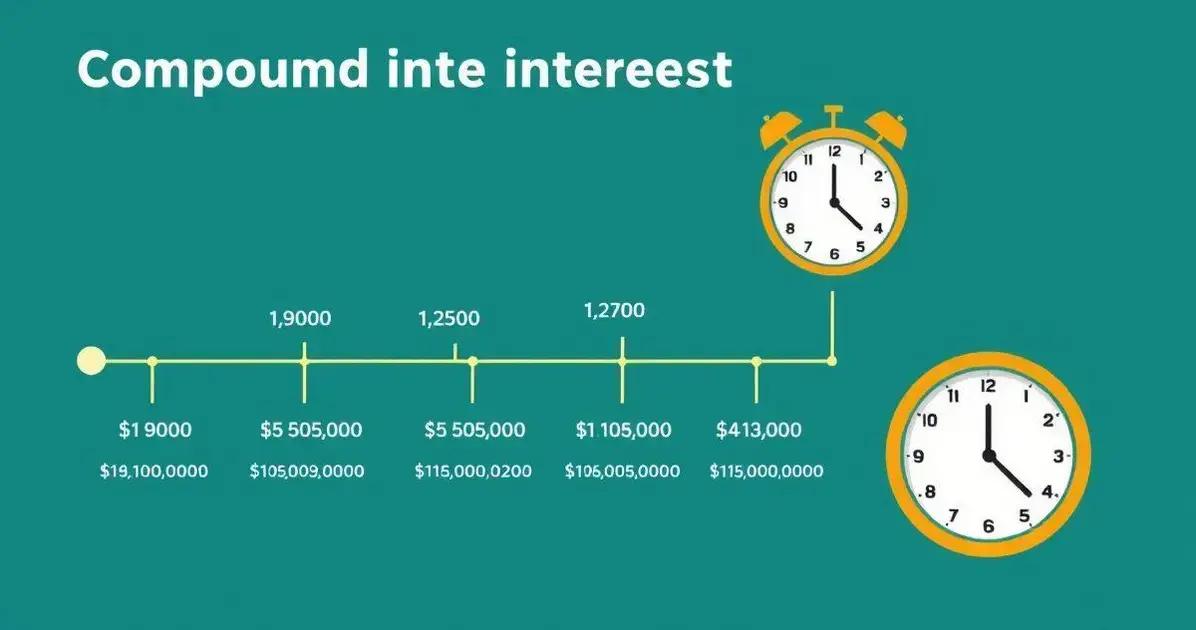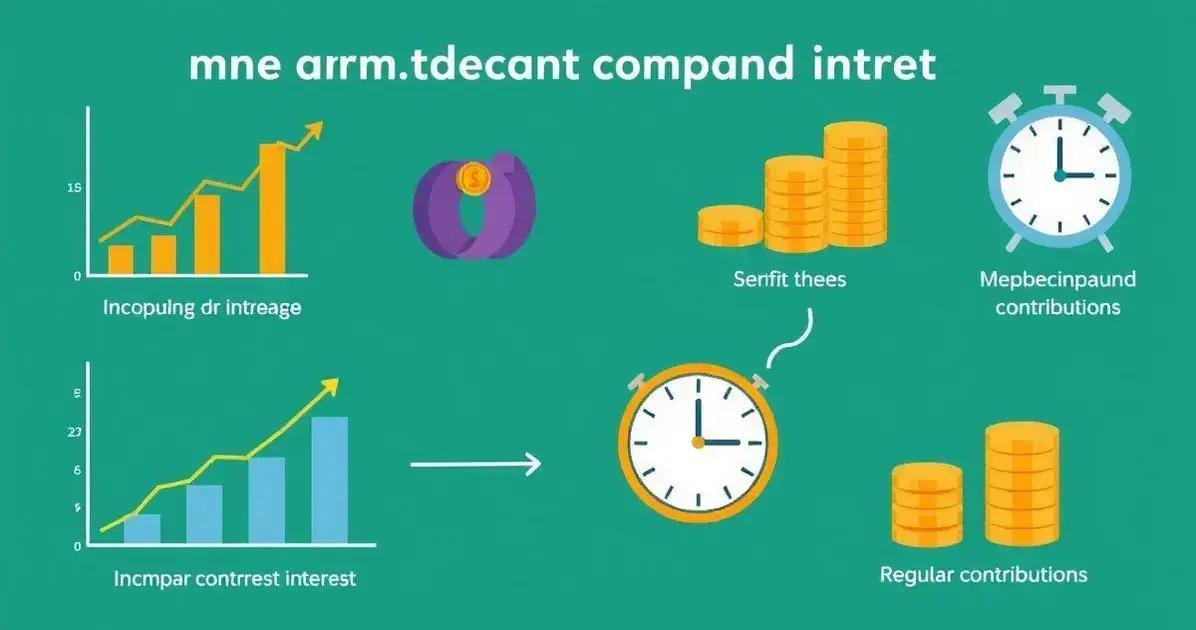Compound Interest: How It Works and Can Transform Your Savings
Advertising
Compound interest is the process of earning interest on both your initial investment and the interest that accumulates over time. This powerful financial tool can significantly increase your savings and investments when you start early, make regular contributions, and reinvest your earnings.
Compound interest is not just a financial term; it’s a key to multiplying your savings. In simple terms, compound interest is the interest you earn on interest. This means that over time, your savings can grow exponentially with each passing period. How does this work? Let’s dive into the importance and strategies of compound interest that can help you achieve your financial goals.
Understanding Compound Interest Basics
Understanding compound interest is crucial for anyone looking to grow their savings. Unlike simple interest, which only pays interest on the principal amount, compound interest allows you to earn interest on both your initial amount and the interest that accumulates over time. This can significantly boost your savings over a long period.
The Formula for Compound Interest
The formula for calculating compound interest is A = P(1 + r/n)^(nt), where:
- A = the future value of the investment/loan, including interest
- P = the principal investment amount (the initial deposit or loan balance)
- r = the annual interest rate (decimal)
- n = the number of times that interest is compounded per year
- t = the number of years the money is invested or borrowed for
Each component plays an important role in determining how much your investment will grow over time.
Examples of Compound Interest in Action
Imagine you invest $1,000 at an annual interest rate of 5%, compounded annually. After one year, you would earn $50 in interest, making your total $1,050. In the second year, you earn interest on $1,050, not just the initial $1,000. In this way, your savings grow faster each year—a powerful effect known as exponential growth.
The Importance of Starting Early
Starting to save early can make a significant difference. Even small amounts can grow into substantial sums due to the nature of compound interest. For instance, if you invest $1,000 today and leave it untouched for 30 years at a 5% interest rate, you would have over $4,300 by the end. The earlier you begin, the more you can benefit from this effect.
Understanding how compound interest works helps you make informed decisions about your savings and investments. It’s a fundamental concept that can empower you to build wealth over time, allowing you to plan for your future effectively.
The Importance of Time in Compound Interest

Time plays a critical role in the power of compound interest. The longer your money is invested, the more you can benefit from compounding. This is because interest gets calculated on the original amount plus the interest that has already been added. Thus, being patient and allowing your investment to grow for a longer period results in significantly higher returns.
The Effect of Time on Investment Growth
Let’s say you invest $1,000 at a 6% annual interest rate. If you keep it in the account for 10 years, your investment would grow to approximately $1,790. However, if you leave it for 30 years, it could soar to around $5,743. This example clearly shows that time enhances the benefits of compound interest.
Why Starting Early Matters
Starting your investment journey early can greatly influence your financial future. Even if you can only invest a small amount, getting started sooner rather than later means your money has more time to grow. This can lead to a much larger amount in the end due to the compounding effect.
Calculating Future Value
To visualize how time affects your investment, you can use the formula for calculating future value: A = P(1 + r/n)^(nt). By changing the t value, you can see how different time periods impact your potential earnings. The longer you invest, the higher the final amount.
Common Mistakes to Avoid
One common mistake people make is withdrawing money too soon. Interrupting the compounding process can significantly reduce your overall gains. It’s essential to understand that compound interest works best when you let your investment grow without touching it for as long as possible.
Remember, patience is key in growing your wealth through compound interest. The longer you wait, the more powerful the effect of time will be in amplifying your returns.
How to Calculate Compound Interest
Calculating compound interest might seem complicated, but it’s quite simple once you understand the formula. The most commonly used formula is A = P(1 + r/n)^(nt), where:
- A = the total amount of money accumulated after n years, including interest.
- P = the principal amount (the initial deposit).
- r = the annual interest rate (in decimal form). To convert a percentage to a decimal, divide by 100.
- n = the number of times the interest is compounded per year.
- t = the number of years the money is invested or borrowed.
Step-by-Step Calculation
To calculate compound interest, follow these steps:
- Start with your principal amount (P).
- Convert the interest rate from a percentage to a decimal by dividing it by 100.
- Decide how often the interest compounds each year.
- Set the number of years (t) that the money will be invested.
- Plug the values into the formula to solve for A.
Example Calculation
For example, let’s calculate the future value of an investment of $1,000 at an annual interest rate of 5% compounded annually over 10 years.
Using the formula:
A = 1000(1 + 0.05/1)^(1*10)
First, perform the calculations inside the parentheses:
A = 1000(1 + 0.05)^{10} = 1000(1.05)^{10}
A = 1000 * 1.62889 ≈ 1628.89
So, after 10 years, the investment will grow to approximately $1,628.89.
Important Tips
Always double-check your calculations and ensure you have the correct values for each variable. Compounding frequency can have a big impact on your results, so consider different compounding intervals like monthly or daily.
Understanding how to calculate compound interest empowers you to make better financial decisions and maximize your savings potential.
Strategies to Maximize Compound Interest

Maximizing compound interest is key to growing your savings and achieving financial goals. Here are some effective strategies to enhance your investment returns:
Start Investing Early
The sooner you start saving and investing, the more you can take advantage of compound interest. Early investments have more time to grow, leading to higher returns over the years.
Make Regular Contributions
Consistently adding to your investment can significantly increase your savings. This can be done through monthly deposits into your savings account or other investment vehicles. Even small amounts can accumulate and gain compound interest over time.
Choose High-Interest Accounts
Look for savings or investment accounts that offer higher interest rates. Online banks often provide better rates than traditional banks. The higher the interest rate, the faster your money will grow due to compounding.
Reinvest Your Earnings
Whenever you earn interest, consider reinvesting that money instead of withdrawing it. This allows your investment to grow even faster since you’ll earn interest on both your initial investment and the interest earned.
Understand Compounding Frequency
The frequency at which interest is compounded affects your total returns. Look for accounts that compound interest more frequently, such as monthly or daily, as these will yield more compared to annual compounding.
Be Patient and Stay Invested
Compound interest works best over long periods. Avoid the temptation to withdraw your savings early. Staying invested for longer allows you to benefit from the exponential growth that comes from compounding.
Implementing these strategies can help you maximize compound interest and significantly increase your savings and investments over time. Becoming financially savvy and making informed decisions about your money is essential for building wealth.
In Summary: The Power of Compound Interest
Understanding and harnessing the power of compound interest is essential for anyone looking to build wealth over time. By starting early, making regular contributions, and choosing high-interest accounts, you can maximize your investment potential.
Additionally, reinvesting your earnings and being patient will allow your money to grow exponentially. The key is to stay informed and apply effective strategies to your savings and investments.
By mastering the art of compound interest, you’re setting yourself up for a financially secure future and unlocking opportunities you may not have thought possible.
FAQ – Frequently Asked Questions About Compound Interest
What is compound interest?
Compound interest is the interest calculated on the initial principal and also on the accumulated interest from previous periods.
How does compound interest work?
It works by calculating interest on both your original investment and on the interest you’ve already earned, leading to exponential growth over time.
Why is time important in compound interest?
The longer you keep your money invested, the more time it has to grow through compounding, which significantly increases your returns.
How can I maximize my compound interest?
You can maximize it by starting to invest early, making regular contributions, choosing high-interest accounts, and reinvesting your earnings.
What is the formula for calculating compound interest?
The formula is A = P(1 + r/n)^(nt), where A is the total amount, P is the principal, r is the annual interest rate, n is the number of times interest is compounded per year, and t is the number of years.
What are common mistakes people make with compound interest?
Common mistakes include withdrawing earnings too soon and not taking advantage of high-interest accounts or compounding frequencies.




